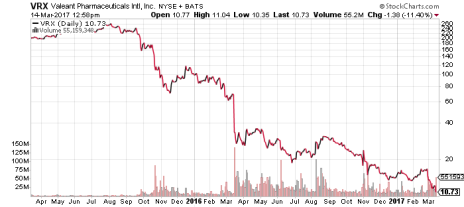Two years ago, Valeant Pharmaceuticals International (VRX) was a hot stock, in the midst of a yearlong rally that took it from 109 to an all-time high of 262. Since then, VRX has all but evaporated, dipping to 10 on Tuesday morning after a 36% nosedive over the last month. For billionaire hedge funder Bill Ackman and his investors, the VRX stock collapse was a costly lesson in knowing when to sell a losing stock.
Ackman’s Pershing Square Capital Management firm took about a $4 billion loss on Valeant stock before finally selling its entire stake—27 million shares and options—this week. He refused to sell his shares in October 2015, after the stock had just lost more than 50% of its value in less than four months. In fact, he stubbornly doubled down on his investment, confident that as an activist investor he could orchestrate a turnaround in a company that was becoming the poster child for price gouging in the pharmaceuticals industry.
[text_ad]
It didn’t work. Valeant stock continued to plummet, falling to 26 in early 2016, to 14 early this year, and is now threatening to touch single digits. The two-year chart below tells the whole sordid story.
VRX has now lost 96% of its value in 18 months. To say that Mr. Ackman violated every longstanding Cabot rule for when to sell a losing stock would be an understatement.
Limiting stock losses is a vital part of investing success. We generally advise the following:
- Let Your Winners Ride
- Take Partial Profits on the Way Up, Selling Some Shares as Your Stock Rises
- Set a Loss Limit—Typically in the 10% to 20% Range
That last investing rule is critical. Selling stocks before they can do serious damage to your portfolio is a way to preserve the gains among your winning stocks. Generally, we advise limiting your losses on a single stock to no more than 20%, though Cabot Small-Cap Confidential Chief Analyst Tyler Laundon gives his small cap stocks a slightly longer leash due to the more volatile nature of small caps. Mike Cintolo advises smaller loss limits in his Cabot Top Ten Trader advisory, typically in the 10%-to-12% range.
By setting strict rules on when to sell a losing stock, you take emotion out of the equation. Ackman refused to sell VRX when the sky was falling because he firmly, passionately believed in the stock and the company. You probably have some stocks in your portfolio that you feel the same way about, either because you love their products, believe in their long-term growth or simply want to be right about the stock. Don’t fall into that trap!
Emotional investing can get you in trouble. By adhering to a stock selling rules, no matter what, you force yourself to coldly cut ties with any losing stock before it poisons your entire portfolio. If Bill Ackman had set a loss limit, he would have saved his investors $4 billion.
[author_ad]


